Novice gardeners today are increasingly choosing apple trees that are grown on dwarf rootstocks, they are also called dwarf apple trees. The fact is that such an apple tree does not cause trouble to care for, and it is also very compact and therefore takes up very little space. Plus, such plants begin to bear fruit already in the third year after planting in open soil, they need less nutrients, and even those areas where groundwater is relatively high are suitable for planting. Moreover, the growing season of such apple trees is somewhat shorter than that of ordinary apple trees. In this regard, a dwarf apple tree can prepare much better for the winter period.
Content
Features of the dwarf apple tree
The dwarf apple tree is not a new species of apple trees. To obtain such a plant, a varietal cutting is taken, which is grafted onto a clonal dwarf stock. The resulting apple trees do not exceed 250 cm in height. The average life span of such apple trees, if properly cared for, is 20 to 30 years, while ordinary vigorous apple trees live slightly longer - from 35 to 40 years.
It happens that columnar apple trees are mistaken for dwarf trees, but these are different forms. There are medium-sized and vigorous columnar apple trees, however, there are also dwarf columnar apple trees, but this plant form does not have a crown. And in a dwarf apple tree, the crown shape is the same as that of an ordinary apple tree, only it is slightly smaller.
Planting dwarf apple trees in open ground
What time to plant
Planting a dwarf apple tree in open soil is practically no different from planting a regular apple tree. It is quite difficult to inoculate and grow a dwarf apple tree seedling with your own hands, since in this case you will need not only strength and time, but also certain knowledge. The easiest way is to buy a seedling from a nursery that deserves your trust. When purchasing a seedling from a random seller, you should be extremely careful not to buy an ordinary game instead of a dwarf apple tree. Examine the seedling. Between the stem and the root collar of the plant, the correct seedling should have a clearly visible knee-shaped protrusion. This protrusion is the site of the inoculation with a fused cut above the grafted kidney. A grafted two-year-old seedling of a dwarf apple tree has at least 4 developed branches, on their tips there are large buds, while the stem does not exceed half a meter in height. And a two-year-old wild game seedling has many sharp branches on which there are no buds. The root system of a dwarf seedling should consist of small elastic roots, while it should be borne in mind that all wild seedlings have a taproot.
For the purchased seedling, the root system should be wrapped with a damp cloth, and wrapped on top with plastic wrap, this will protect the roots from possible injuries during transportation. Before directly planting a seedling in open soil, it is necessary to shorten its branches. Planting a bonsai seedling can be done at the beginning of the spring period or in the fall, while the plant is at rest.
Planting a dwarf apple tree in autumn
Seedlings are planted in open soil in autumn from the second half of September to mid-October, at which time the plant begins to enter a state of dormancy.
For planting, you should choose a well-lit area or one that is in partial shade. It must have reliable protection from drafts, while the groundwater must be located at a depth of at least 150 cm. Wet and loose soil is suitable for planting, it is also very important that it is saturated with nutrients, since the root system of such a tree is superficial, therefore " it cannot eat, penetrating into the deep layers of the soil. The best option for planting is medium or light loam.
The depth of the planting pit should reach 0.7 m, and its diameter - 0.6 m. When preparing the pit, the top layer of soil about 20 centimeters thick must be thrown aside. It should be combined with a pair of buckets of peat or humus, 0.7 kg of wood ash and 0.6 kg of superphosphate. In the middle of the prepared pit, a stake must be installed, after which a mixture of the top layer of soil with fertilizers is poured around it with a mound. On top of this nutrient mixture, a layer of simple soil from the top layer is poured, its thickness should be equal to 20-30 mm. After that, a seedling should be installed on the hill. When its roots are carefully straightened, the hole must be covered with soil from the top layer not mixed with fertilizers. It should be noted that the grafting site after planting should rise above the soil surface by 30 mm. You also need to remember that the roots of the seedling should in no case come into contact with the soil mixture in which the fertilizers are located, as this can lead to burns on them. When planting several seedlings, a distance of at least 300 cm should be observed between them.
When the apple tree is planted, you need to compact the soil well in the trunk circle, for this you need to stamp it down. Then you need to retreat from the trunk about 50 centimeters and make a roller fifteen centimeters high. Then pour 2.5–3 buckets of water into the trunk circle. After the liquid is completely absorbed into the soil, the surface of the trunk circle must be covered with a three-centimeter layer of mulch (peat or humus). Then the plant is tied to the peg.
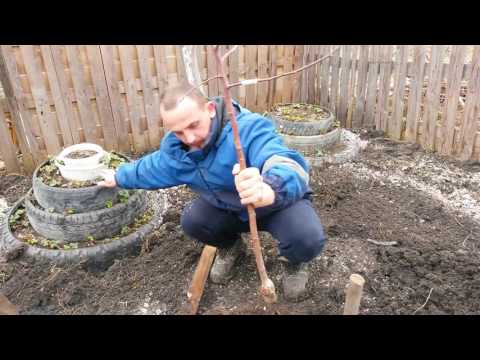

Watch this video on YouTube
How to plant a dwarf apple tree in spring
Planting a dwarf apple tree seedling in the spring should be done when the soil has already completely thawed, but the buds should not yet begin to bloom. It is recommended to prepare the planting pit in advance, even in autumn, while it will be necessary to add a soil mixture with fertilizers to it. In winter, the soil will have time to settle well and compact, and the fertilizers will be able to dissolve during this time.
In spring, in the middle of the pit, it is necessary to install a stake, around which the soil is poured from the top layer in a mound. A seedling is installed on this hill and further planting is carried out according to the same plan as in the autumn.
Caring for dwarf apple trees in the garden
How to care in springtime
Compared to ordinary apple trees, growing a dwarf apple tree is much easier, but this is only if you know all the nuances. At the beginning of spring, the branches of newly planted seedlings should be slightly shortened. If the tree has not been growing for the first year, then at this time it will need sanitary and formative pruning. Before sap flow begins, trees should be treated to prevent pests and diseases. They also install trapping belts on the trunks, which are designed to catch pests.
In such apple trees, the root system is superficial, in this regard, it is very important to ensure that the surface of the soil in the near-trunk circle does not dry out. When the plant is watered, it is necessary to loosen the soil surface in the near-trunk circle to a shallow depth (from 50 to 70 mm). To reduce the number of waterings and prevent rapid evaporation of moisture, it is recommended to cover the surface of the trunk circle with a layer of mulch. In April, on a fine day, you should whitewash the trunk and the base of the skeletal branches of the tree, for this they use lime. In spring, you should also feed the apple tree with complex or nitrogen-containing fertilizer.
Summer care
In summer, special attention should be paid to watering the apple tree. Remember that the soil in the trunk circle should not dry out. Also, in the summer, the plant is often attacked by pests, and in order to get rid of them, you can use both folk remedies and chemical preparations.
In summer, a dwarf apple tree is most often fed on a leaf, while it is recommended to add trace elements to the nutrient solution, especially at this time the tree needs iron. During the period of fruit filling, do not forget to install supports so that the branches, weighed down by apples, do not break.
Autumn care
In autumn, most varieties of dwarf apple trees ripen. In this regard, the main occupation in the autumn months is harvesting. Please note that the trunk circle at this time must be constantly clean, therefore, fallen leaves and fruits, as well as other debris, must be promptly removed from it. When the crop is harvested, the tree must be fed, using mineral fertilizers for this, and sanitary pruning is also performed.
After the near-trunk circle is cleared of plant debris (foliage, cut branches, etc.), it must be loosened, which will lead to a violation of the thermal insulation of harmful insects that have settled down for the winter in the soil. In the middle of the autumn period, the apple tree should be treated for preventive purposes from pests and diseases. In late autumn, you need to prepare the tree for wintering.
Treatment
In spring, before the buds swell, apple trees need to be treated with Nitrafen solution or Bordeaux mixture (1%) in order to get rid of fungi and harmful insects that hibernated in the bark and in the surface of the trunk circle.For processing, you can use a urea solution (7%), it will not only get rid of pests and diseases, but also become a source of nitrogen for the plant. You need to spray the bushes before the sap flow begins, otherwise the buds that have begun to bloom will be burned. In autumn, when the leaf fall ends, the dwarf apple trees are re-treated. To do this, use a solution of Nitrafen or Bordeaux mixture (1%).
How to water
The mode and abundance of watering directly depends on the age of the apple tree, as well as on the weather. The trees that have not begun to bear fruit during the season need three waterings, while 50 liters of water are poured under one plant at a time. The last time the apple tree needs to be watered is in the first days of August. The trees that have entered fruiting need more frequent watering, during the season there should be 3-5 of them, namely: before the tree blooms, during flowering, before the ovaries fall off (in June) and before the apples begin to ripen.
If the soil is sandy loam, then 40 liters of water should be poured under 1 tree at a time, but if it is loamy, then 60 liters of water will be needed. If there was a drought in the summer and there is also very little rain in the fall, the plant will need moisture-charging podzimny watering. At the same time, you must try to get the soil wet to the depth of the root system, for this, 1 bucket of water is taken per 1 square meter of the garden. If the groundwater on the site is located relatively close to the soil surface, then water-charging podzimny watering is not needed for such an apple tree.
Fertilizer
Since the root system of an apple tree on a dwarf rootstock is not very large, and fruiting at the same time is distinguished by its abundance, it is necessary to systematically feed it 1 time in half a month. In the second and third years of growth, the plant will need additional fertilizing with complex fertilizer (for 10 liters of water, 30–40 grams of the substance). At least 2 times during the season, it is recommended to feed the apple tree with organic matter, for this you can use a solution of chicken manure (1:20) or mullein (1:10), while 10 liters of nutrient mixture are taken for 1 bush. In the summertime, foliar complex dressings are produced and mineral fertilizers are used for this. In this case, the foliage should be sprayed with a nutrient solution on both sides. Such a procedure is carried out in the early morning or late evening, while the day is chosen to be calm and dry. It is also recommended to feed the apple tree on the leaf with a solution of urea, but its concentration should be low, otherwise burns will remain on the surface of the foliage. The last time you can feed the plant on a leaf is no later than September. In autumn, the fertilizers used for top dressing should not contain nitrogen, as it stimulates the growth of young shoots, which leads to a delay in the preparation of the tree for wintering. In autumn, the plant needs most of all phosphorus and potassium. The approximate composition of the dressing per 1 square meter of the plot: 2 tbsp is poured into 1 bucket of water. l. double superphosphate and 1 tbsp. l. potassium.
Wintering
Since the root system of such a plant is located close to the surface of the site, in a cold winter with little snow, it can freeze out. In order to prevent this, the trunk circle must be covered with compost or humus, while the layer must be thick enough. From above it is still covered with spruce branches. After the snow has fallen, if you wish, you can remove the spruce branches, and instead of it, the trunk circle is thrown with a thick layer of snow, because even a very severe frost cannot harm the apple tree under it.
Pruning dwarf apple trees
What time to trim
In order for the yield of a dwarf apple tree to be consistently high, it must have a properly formed crown. If we neglect the formative scraps, then every year the fruits will become less and less, and after 3 or 4 years, several fruits of not very good quality will show off on the tree at best.Formative pruning occurs in March – April. At the same time, sanitary and anti-aging pruning is carried out. After the entire crop is harvested in the fall, the plant will need repeated sanitary pruning.
Pruning rules
The rules for the formative pruning of dwarf apple trees are the same as for the formation of the crown of vigorous apple trees, but it is carried out in a shorter time. There are several types of crowns for dwarf apple trees: slender spindle, flat spindle, free palmette, and dwarf pyramid. Moreover, the last type on this list is the most popular among gardeners. So, a tree is formed from a plant, the height of which does not exceed 250 cm, while the average length of the branches will be about 100 cm.
Spring pruning
Before the sap flow begins in the spring, sanitary pruning of the tree should be done; for this, all injured, frost or disease damaged, as well as improperly growing branches are removed. At the same time, formative pruning is carried out. They begin to form a dwarf apple tree already in the first spring after planting a seedling. To do this, the plant should be shortened to 0.5 m, while the cut is made on the kidney opposite to the graft. As a result, at the end of the season, the plant should have 4 or 5 powerful shoots, while the topmost (future conductor) should grow almost vertically. Next season, the conductor should be trimmed 20 centimeters from the base of the growth on the kidney opposite to the cut that was made last season. This allows the conductor to be as vertical as possible. The remaining branches (there must be at least 4 of them) must be shortened to 20 centimeters from the base.
Lateral shoots that are not involved in the formation of the skeleton of the tree must be cut off into 3 leaves, and the shoots of the second order on the first leaf from their base. Such procedures begin to be carried out from the last days of July and end them only when the length of uncut shoots reaches 20 centimeters. For the third season and all subsequent ones, the plant should be cut in the same order; for this, the conductor is shortened by 20 centimeters per kidney, which is located opposite to last year's cut, which will preserve its vertical position. After the apple tree reaches the required height, every year it will be necessary to cut off the entire growth of the guide. After the length of the skeletal branches is equal to 0.45–0.5 m, their lateral growths will also need to be cut off. If necessary, you need to deal with the thinning of overgrown branches. In order for the fruiting branches to be directed horizontally, they should be shortened to a growth that is oriented downward. To keep the shape of the crown pyramidal, the growth of the upper branches must be controlled.
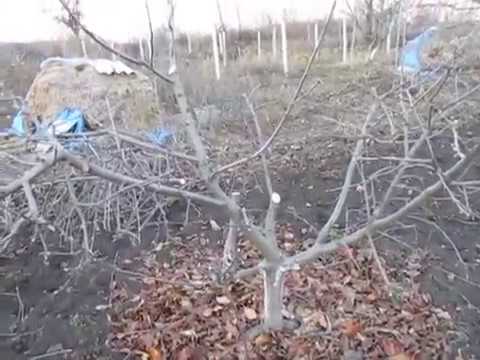

Watch this video on YouTube
Autumn pruning
In the process of collecting fruits, part of the branches is injured or breaks off in this regard, when leaf fall ends, the plant will need sanitary pruning. During its implementation, it is necessary to cut off all dried, improperly growing, injured, competing and diseased stems and branches. All slices that are thicker than 0.7 cm need to be treated with a garden pitch. If it is colder than minus 5 degrees outside, then the pruning should be postponed, since in such cold weather the wood is very fragile, and serious harm can be caused to the tree during pruning.
Reproduction of dwarf apple trees
Weak rootstocks are most often propagated by vegetative methods: horizontal and vertical layering, intercalary insertion, root, lignified and green cuttings, as well as budding. The main difficulty in growing an apple tree on a dwarf rootstock is that such a seedling is very difficult to get, and it also has a relatively high cost.
Is it possible to grow a dwarf stock with your own hands? There are several ways to do this.
Propagation by vertical layers
Two-year-old dwarf rootstock seedlings are well suited for this breeding method. It should be planted in open soil, with a part of the stem 10-15 centimeters buried in the ground. In spring, the part of the plant located above the ground should be shortened to 15–20 mm, while the remaining hemp should have 2 or 3 buds. After the length of the shoots grown from these buds is 12 to 15 centimeters, when watering is done or it rains, the stump will need to be covered with peat, sawdust or nutritious soil to a height of 60 to 100 mm. Before starting hilling, it is imperative to carefully spread the shoots. After their length reaches 20-25 centimeters, you need to huddle them again with a gentle and wide hill, while nitrogen-containing fertilizer is introduced into the soil. On vertical layers, the roots will begin to grow after 35–40 days. At this stage, it is very important to maintain high soil moisture (75 to 80 percent). You also need to regularly weed and loosen the soil. In autumn, the soil must be carefully removed and with the help of a pruner, separate the layers (shoots with formed roots), while leaving 10–20 mm of growth on the stump. The separated cuttings should be planted in open soil. The uterine bush must be covered with earth, since, with proper care for 10 years, it will produce from 5 to 10 layers every year, and varietal cuttings can be grafted on them.
Propagation by horizontal layers
You will need strong dwarf rootstock stems that are low growing. They should be laid in pre-prepared shallow (from 30 to 50 mm) grooves, after which they are fixed with metal pins and sprinkled with a layer of soil. In spring, all the earth must be carefully removed from the horizontal layer, and the vertical shoots that have grown from it will need hilling to a height of 12 to 15 centimeters, which later needs to be repeated, but already to a height of 20 to 25 centimeters. At the base of the layering, it is recommended to pull with a soft wire, which will have a positive effect on the formation of their roots. In autumn, the cuttings should be cut off from the parent bush, removed from the ground, divided into several parts and planted in open ground in a permanent place. Such layers are of higher quality compared to vertical ones.
How to propagate by intercalary insert
Dwarf rootstocks have one big drawback, their root system is located very close to the soil surface, and therefore it can be severely damaged due to severe frosts in winter with little snow, which often leads to the death of the tree. But it is quite possible to get rid of this disadvantage. To do this, it is necessary to apply the combined method of creating a dwarf apple tree using an intercalary insert - this is an intermediate link between the stock of a vigorous apple tree and a varietal cut, which is a cut of a dwarf tree. As a result, a three-story structure is created: first there is a well-developed and powerful root system of a vigorous apple tree, then a dwarf apple stalk grafted onto it, and then a cultivar stalk grafted onto it. Trees with such inserts can be planted in open soil in different ways:
- after planting, the insert should rise above the surface of the site;
- the seedling is planted with the insertion deepening into the soil, and after some time, it will also develop a root system.
How to propagate by green cuttings
For propagation by green cuttings to be successful, you need a greenhouse, in which you need to create fog. Harvesting is carried out in mid-June, while young shoots should be used to cut green cuttings with three leaf plates.The upper cut must be made above the third sheet plate, and the lower one - under the kidney. The lower leaf plate must be torn off, after which the cuttings must be tied, and their lower cuts must be dipped into a solution that promotes root formation for 18–20 hours. After the cuttings have been rinsed in clean running water, they should be planted in a greenhouse using the scheme 4x6 centimeters. It should be borne in mind that the soil mixture must be loose and consist of sand and peat. You will need a special installation that will help create a foggy environment in the greenhouse, since moisture should be present on the foliage all the time. In the summer, cuttings that have given roots must be planted in open soil, where they will grow for 1 year. Then they are used as dwarf rootstocks for varietal cuttings.
How to propagate lignified cuttings
Lignified cuttings are harvested in autumn during the extraction of cuttings from the soil. The length of the cuttings with the etiolated lower part should be at least 0.2–0.3 m. Before planting, the cuttings are stored in the basement, they are buried in moistened peat or sand and kept at a temperature of 2–5 degrees. At the beginning of the spring period, these cuttings are planted in an unheated greenhouse, while a distance of 10 centimeters should be kept between them, it should also be taken into account that only 2 or 3 buds should remain above the surface of the site. In order for the cuttings to root well, it is necessary to maintain high humidity in the greenhouse (from 75 to 80 percent).
How to propagate by root cuttings
To obtain columnar rootstocks using this method, you need to ask your neighbors or buy a few pieces of root cuttings in the nursery, they should be 8–12 centimeters long and 0.6–1 centimeters across. For the winter they are stored in peat or sand and kept at a temperature of 2-5 degrees. 15–20 days before planting for rooting, cuttings are removed to a warmer place (from 15 to 20 degrees). In spring, cuttings should be planted in open soil, while in a row between them, a distance of 8-10 centimeters must be maintained. It is necessary to place the cuttings in the soil vertically, while making sure that the thickness of the soil layer above the upper cut is at least 20 mm. Several shoots should grow from the cuttings, which must be removed, leaving only the most branched. The main condition for successful reproduction in this way is a constantly slightly moist soil.
How to propagate by budding
Budding is carried out in mid-July. You need to take a shield with an eye of a varietal cuttings, a leaf petiole and a thin layer of wood, which is inserted into the cut of the bark of a dwarf rootstock, which has a T-shape and is located slightly above the knee. Then the vaccination site must be wrapped with eyepiece tape, you can take another sufficiently elastic material, while the peephole with a petiole should not be closed. After 15–20 days, the shield will have to completely grow together with the stock. In order for budding to be exactly successful, 2 eyes of the same variety are grafted at once, and they are placed on opposite sides of the stock. After the shield has exactly taken root, it will be necessary to remove the eyepiece tape, and with the onset of spring time it will be necessary to cut the rootstock onto the grafted bud, after which the base of the shoot, which grows from the grafted peephole, is covered with earth. Next spring, it will be possible to start forming the crown of a dwarf apple tree.
Diseases of dwarf apple trees
An apple tree on a dwarf rootstock can suffer from the same diseases as tall apple trees, or rather, such a plant can infect: witch's broom (proliferation), bitter fruit rot, milky shine, mosaic, mosaic ringing, powdery mildew, fly-eater, tinder fungus, common cancer, scab, dying off of branches, pome fruit rot, subcutaneous viral spotting, rubbery, rust, flattened branches, vitreous fruit, black cancer and cytosporosis.
If the plant is affected by a fungal disease, then fungicidal preparations must be used for treatment, for example: iron or copper sulfate, Bordeaux liquid, colloidal sulfur, Quadris, Skor, Horus, Fundazol, Ridomil, Topaz, etc.Mycoplasma and viral diseases are considered incurable, in this regard, the affected areas are excised to healthy tissue, after which they are treated with copper sulfate. At best, the tree will be able to recover and continue to grow, and if not, then it should be removed from the soil and destroyed.
Preventive measures to protect the dwarf apple tree from disease:
- adhere to the rules of agricultural technology of this plant;
- carrying out preventive spraying of the apple tree in spring and autumn;
- proper care of the garden;
- keeping the trunk circle clean;
- regular correct processing of trees against fungal diseases;
- timely cleaning of plant residues, as well as loosening of the soil in the near-trunk circle.
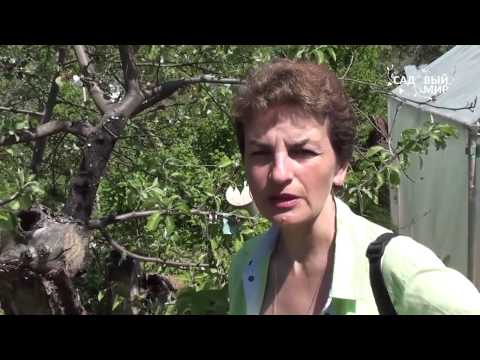

Watch this video on YouTube
Pests of dwarf apple trees
A dwarf apple tree can be harmed by such harmful insects as: apple-plantain aphid, apple sawfly, glassworm, moth, moth, leaf roll moth, honeydew moth, comma-shaped scabbard, fruit striped moth, blue-headed scoop, currant leafworm, mountain ash moth , subcrustal and fruit moth, fruit moth, pear beetle, unpaired, ringed and oakleaf silkworms, miner moths, blood and red gall aphids, red apple tick, goose, winter moth, green apple aphid, western unpaired bark beetle, sapweed and pear beetle , oriental moth, apple blossom beetle, upper-sided fruit moth, brown fruit mite, hawthorn and hawthorn moth.
Almost all such harmful insects, except for apple trees, can also infect other garden crops, for example: plum, mountain ash, sweet cherry, apricot, quince, pear, bird cherry, cherry, cherry plum. Moreover, from the affected plant, they can fall on healthy specimens, if the fight against them was not started in a timely manner. Most importantly, it should be remembered that the best protection of an apple tree on a dwarf rootstock from various pests is timely preventive treatments.
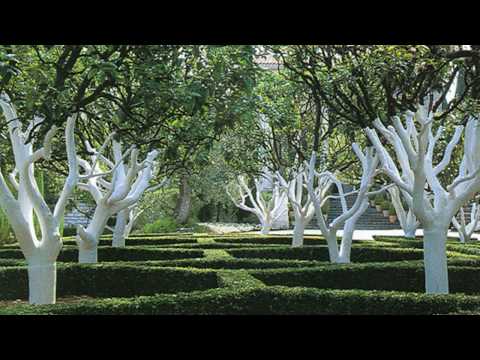

Watch this video on YouTube
Dwarf apple varieties
All varieties on a dwarf rootstock are divided according to the ripening period into winter (late), autumn (mid-season) and summer (early). Such a division of varieties is also present in tall apple trees. It has already been said above that the main difference between dwarf and vigorous apple trees is that tall and medium-sized apple trees have a pivotal root system, and it goes deep into the soil, while low-growing trees grown on dwarf rootstocks have a surface root system. Precisely because dwarf apple trees have such a root system, it is very important for novice gardeners to know which varieties are best grown in regions with cool as well as cold climates.
Dwarf apple trees for the Moscow region
It is recommended to grow the following varieties of dwarf apple trees in the Moscow region:
- Melba... This early variety has a high yield. The fruits have a rounded-elongated shape and a green-yellow color with a streak-like red blush. They weigh an average of 150-250 grams, and their ripening is observed in the last days of July. The juicy and tender pulp has a sweet-sour caramel flavor.
- Candy... This early variety, distinguished by its aroma and unpretentious care, was born thanks to Michurin himself. It is still distinguished by the highest taste of all early varieties. The yellow fruits have a brown-red blush and weigh about 120 grams. They ripen in the first half of August. The dense and juicy pulp is sweet enough.
- Zhigulevskoe... It is a mid-season variety that is distinguished by its yield, vitality and resistance to pests and diseases.The fruits are very large, they have a striped orange-red color. Ripening is observed in the last days of September. The fruits can be stored for 6 months. The coarse-grained delicate cream-colored flesh has a moderately sour taste. Such a plant can be damaged by very severe frosts.
- Autumn striped... This variety is autumnal. Rounded fruits are colored in a rich yellow color, on average they weigh 200 grams. The taste of the pulp is intense, sweet and sour. The fruits keep very well in a cool place (about 6 degrees).
- Grushovka near Moscow... This winter variety with high yields and scab resistance has been very popular with gardeners for a long time. Small fruits are round-elongated and yellow in color with a red barrel.
- Bogatyr... This late variety is distinguished by its frost resistance, as well as high resistance to pests and diseases. The crown of such trees is highly branching. Yellow-red fruits have a slightly elongated shape, as well as a slightly sour taste (reminiscent of Antonovka).
In addition to these varieties, in the Moscow region, you can grow Moscow necklace, Snowdrop, Carpet, Land, Northern Sinap, Antonovka, Legend, Moscow red, Nizkosloe, etc.
Dwarf apple trees for the Urals
The varieties of dwarf apple trees that are recommended to be grown in the Urals are more frost-resistant than those grown in the Moscow region. It is recommended to grow the following varieties in this region:
- Wonderful... This late summer variety is high-yielding and hardy. Slightly ribbed flat-rounded fruits are colored greenish-yellow, on average they weigh about 140 grams and have a dark red blush. The taste of the pulp is dessert.
- Bratchud... This name stands for "Brother of the Wonderful". This winter variety is distinguished by its high productivity and frost resistance. Ribbed oblong-rounded apples are of medium size and yellow-green in color, on average they weigh about 120 grams. These fruits also have a characteristic side seam. The pulp is coarse-grained and slightly juicy, it has a wonderful sweet-sour taste.
- Grounded... This frost-resistant autumn variety is distinguished by its high productivity and scab resistance. It is able to withstand frosts down to minus 40 degrees. The flat-rounded fruits are green with a deep red blush, their average weight is about 150 grams. The pulp has a wonderful sweet and sour taste.
- Sokolovskoe... The late frost-resistant variety is distinguished by its yield and scab resistance. Yellow-green apples have a glossy skin and a red blush, their average weight is about 200 grams. The creamy pulp is dense, juicy and fine-grained, it has a sweet and sour taste.
- Snowdrop... This late variety is characterized by frost resistance and productivity. Slightly ribbed yellowish apples have a blurry light red barrel, and they weigh about 160 grams (sometimes fruits weighing up to 300 grams are found).
Also in the Urals, you can cultivate such varieties as: Sun, Early Sweet, Low, Carpet, Ural Liquid, Krasa Sverdlovsk, Ksenia, Bashkir handsome, Shreifing, Yantar, etc.
Dwarf apple tree for Siberia
In Siberia, it is possible to grow only those varieties of apple trees on dwarf rootstocks that have a very high frost resistance, while they must withstand frosts below minus 40 degrees. The best varieties for Siberia:
- Ermakovskoe mountain... This early variety is distinguished by its yield. It was obtained by crossing the varieties Felix Altai and Altai Dove, it cannot be damaged by a decrease in air temperature to minus 51 degrees. Small, round and smooth apples are yellowish with a reddish streak on almost their entire surface. On average, they weigh about 80 grams.Fragrant juicy fine-grained white pulp has a sweet and sour taste.
- Antonovka dessert... This autumn variety is characterized by frost resistance and scab resistance, it was obtained by crossing the varieties of Pepin saffron and Antonovka ordinary. Rounded creamy green apples with a slight speckled red blush weigh 150-200 grams on average. The juicy fragrant pulp has a medium-grained structure and a sweet-sour taste.
- Arkadik... An early variety with high productivity. Ripening occurs in mid-August. Elongated apples have a red-striped color, they weigh 160 grams on average. The juicy sweet pulp of white color has a pleasant dessert taste.
- Winter lungwort... It is a hybrid late variety that is scab resistant. Round-conical greenish-yellow apples weigh on average up to 120 grams and have a vague red blush. Medium white pulp has a freshly sweet taste. Apples can lie until March.
- Delight... This variety is early autumn. Round-conical apples of greenish-yellow color have a raspberry-red blush, which occupies most of the surface of the fruit. The average weight of apples is 150 grams. Sweet-sour juicy fine-grained pulp with a slight raspberry flavor is painted white with light pink veins.
- Gift to Grafsky... This late variety is distinguished by high productivity and resistance to fungal diseases. Weakly ribbed round-conical yellow apples have a reddish-purple blush, which is located on most of the fruit. Medium yellowish pulp has a sweet-sour taste and a mild aroma.
The best varieties of dwarf apple trees
Considering how unpretentious the variety is to care for, winter and drought resistant, resistant to pests and diseases, what taste it has, etc., the best include: Bratchud, Carpet, Low-growth, Snowdrop, Land, Early sweet, Solnyshko, Sokolovskoe and Wonderful ...

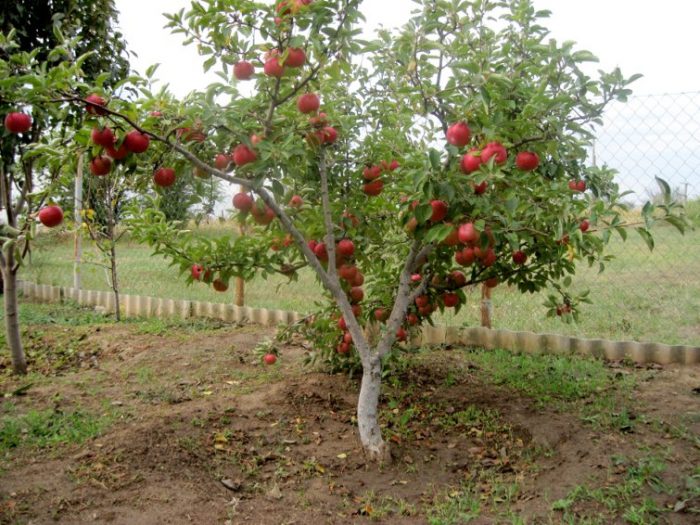
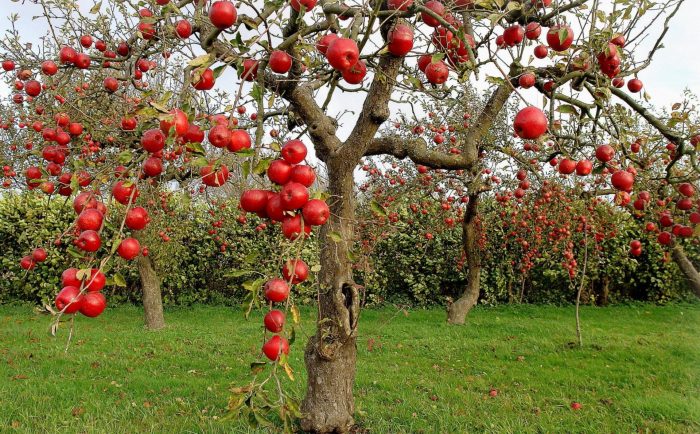



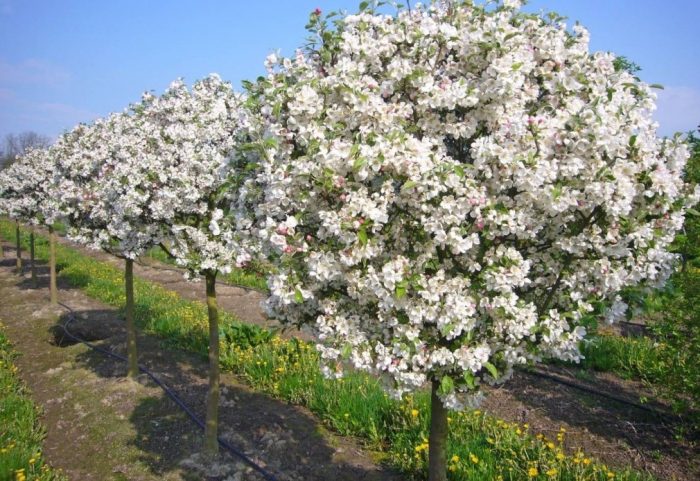
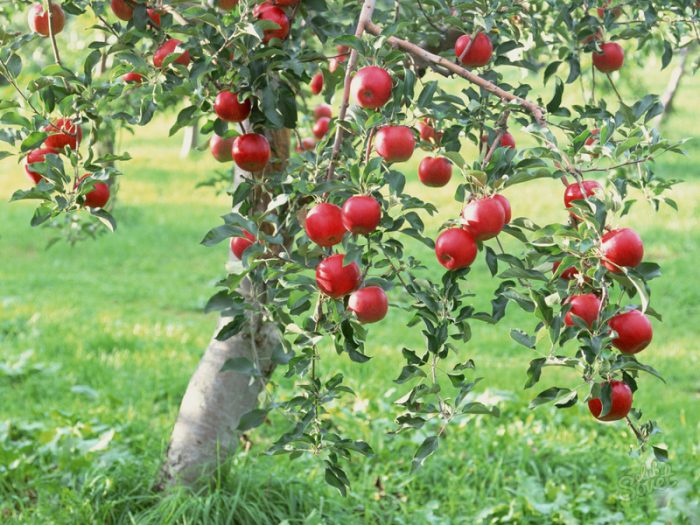
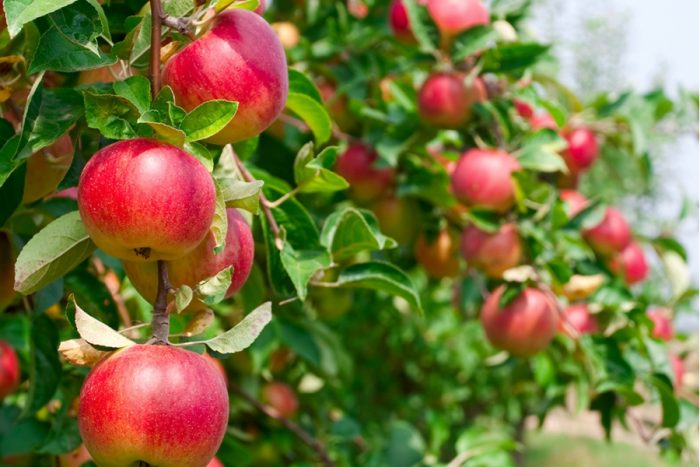
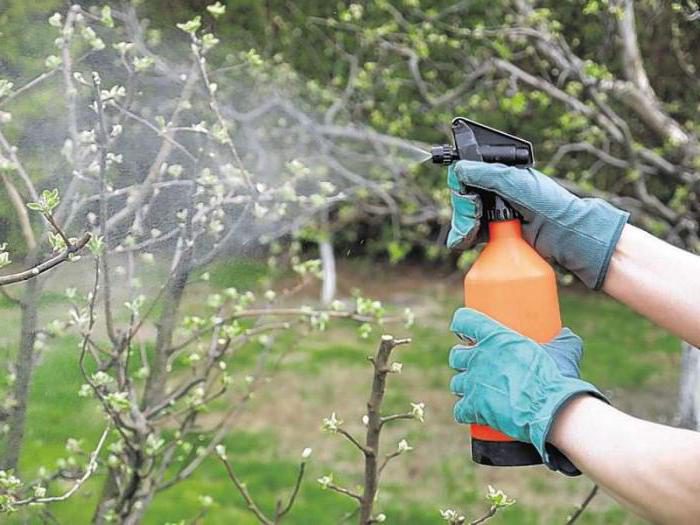
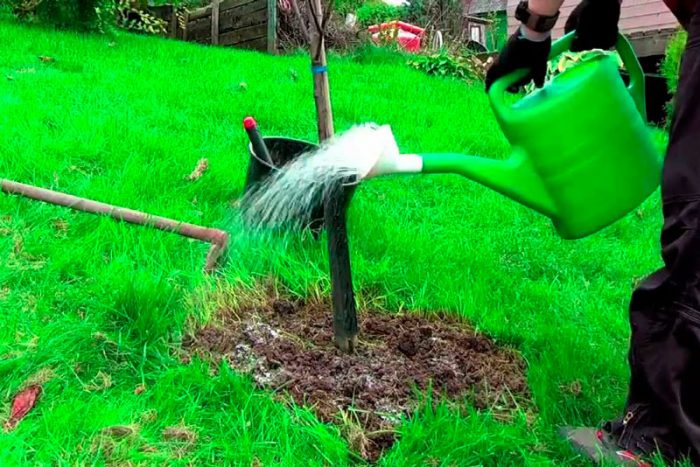
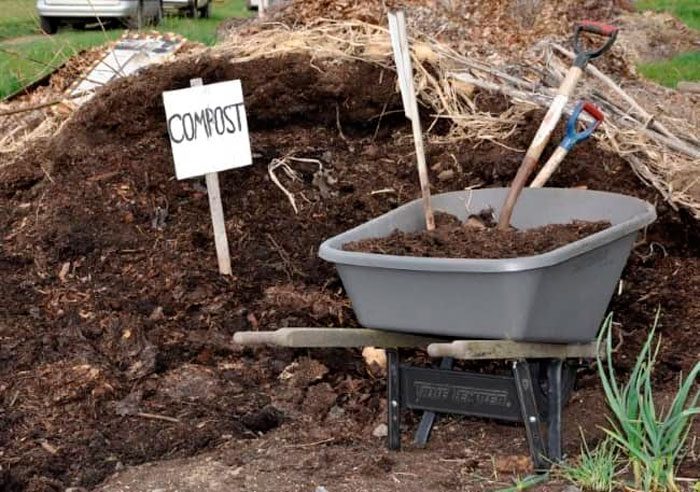
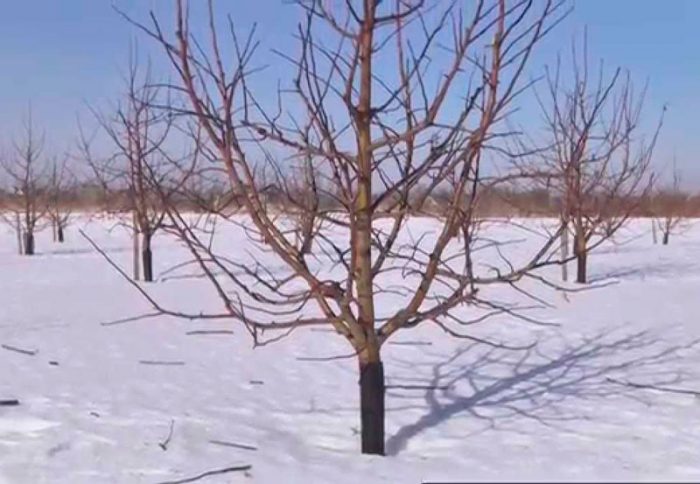
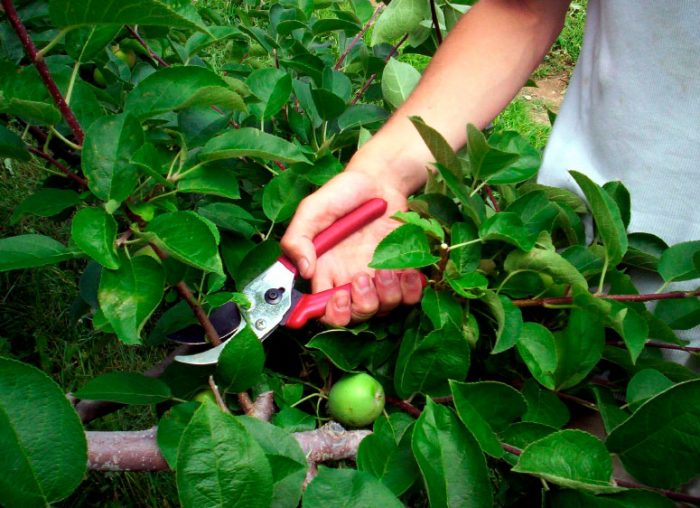
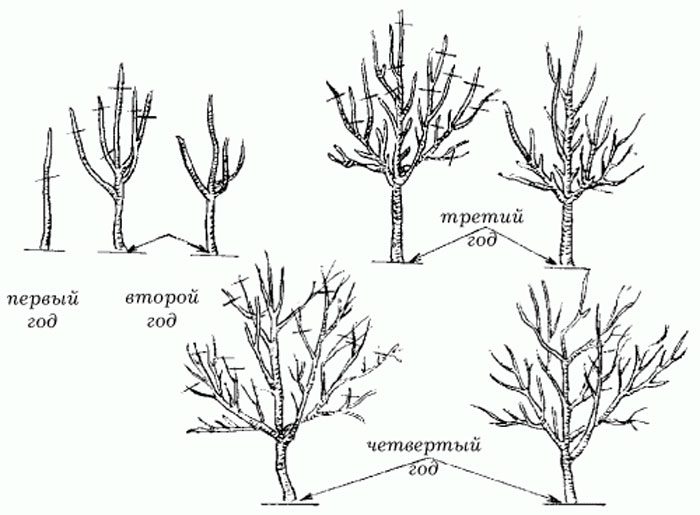
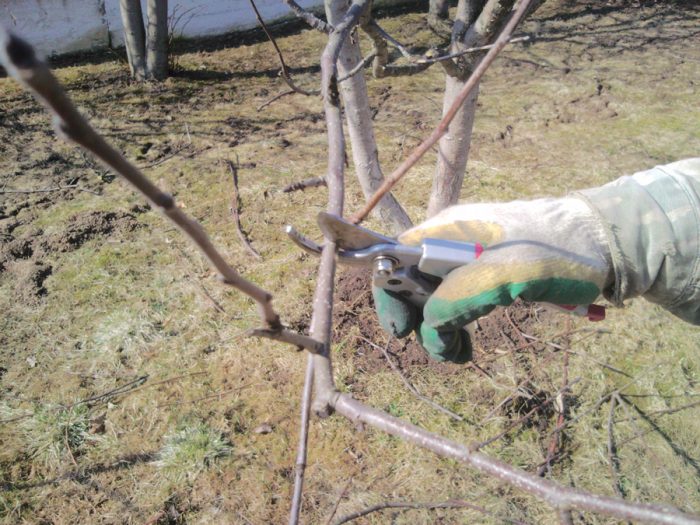
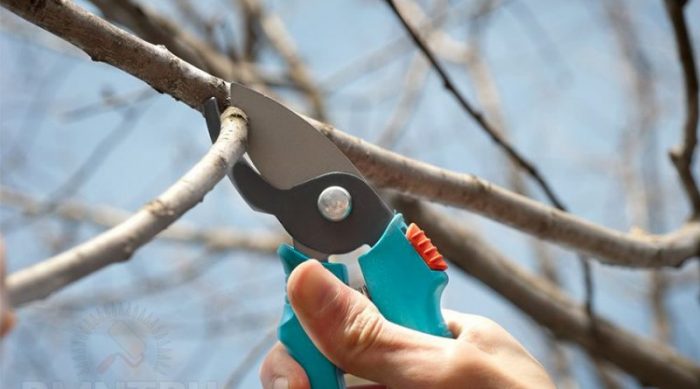


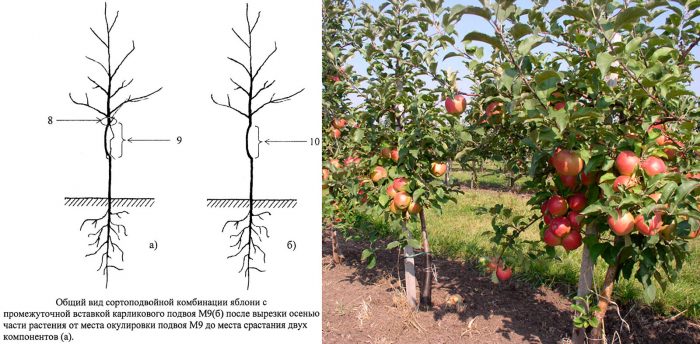



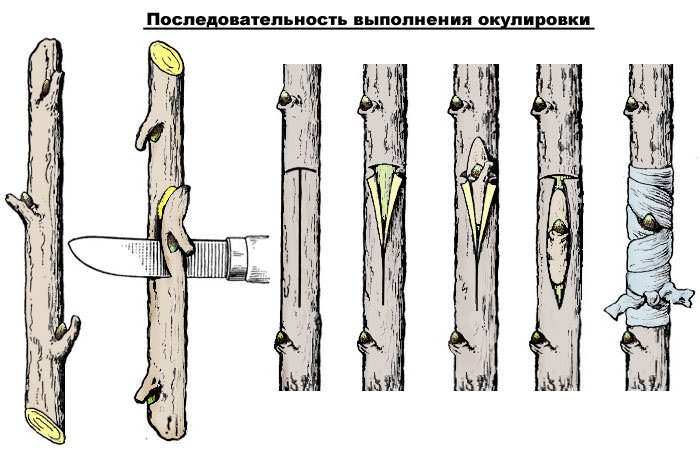

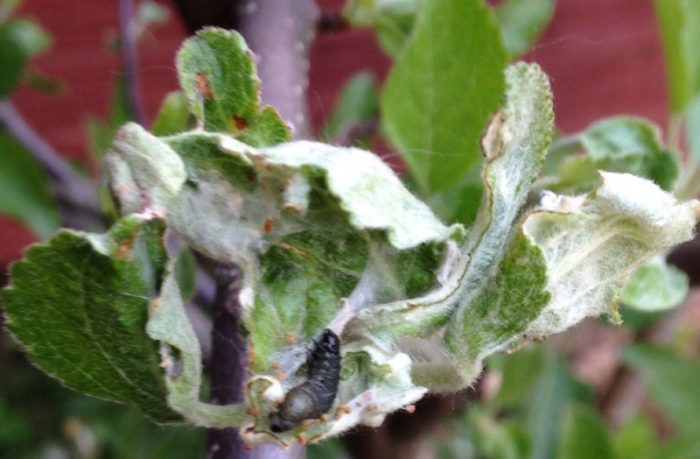

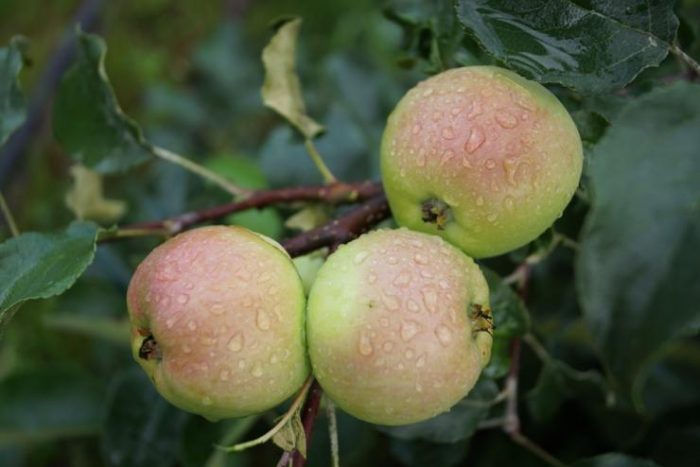


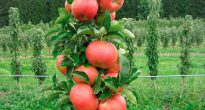









Very useful information. I want to grow a large apple and pear orchard and learn more about it
Thank you very much for the very interesting information!
Thank you very much for the very interesting information! When landing, I will be under your advice!